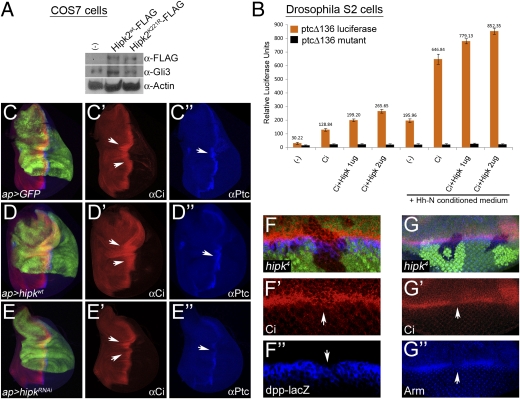Fig. 4.
Hipk2/Hipk inhibits SCFβ-TrCP/Slimb-mediated ubiquitination of Gli3/Ci to promote Hedgehog signaling. (A) Transfection of COS7 cells with Hipk2WT stabilizes endogenous, full-length Gli3 (lane 2), relative to the untransfected control (lane 1). Hipk2K221R does not have any effect on the levels of full-length Gli3 (lane 3). (B) A transcriptional assay performed in Drosophila S2 cells shows that Hipk significantly up-regulates the expression of a Ci-responsive reporter gene ptcΔ136-Luc in a dose-dependent manner, both in the absence (P < 0.0009) and presence (P < 0.01) of Hh pathway activity. The mutant reporter ptcΔ136-Luc shows no response to Ci levels and Hh pathway stimulation. (C–E) Expression of hipk using ap-Gal4 increases both the amount of stabilized Ci and ptc expression (D, D’, and D’’), relative to a wild-type wing disc (C, C’, and C’’). Conversely, knockdown of hipk reduces the levels of stabilized Ci and results in lower levels of ptc expression. (E, E’, and E’’). Arrows indicate the region of the disc in which stabilized Ci and Ptc are affected. Loss-of-function clones for hipk in the eye disc induced using the ey-flp strain show a reduction in the levels of stabilized, full-length Ci and the Hh target gene dpp (F, F’, and F’’). Loss-of-function clones for hipk in the eye disc show a reduction of both Arm and Ci, indicating that Hipk dually regulates both the Wg and Hh pathways (G, G’, and G’’). Arrows indicate locations of hipk loss of function clones.

